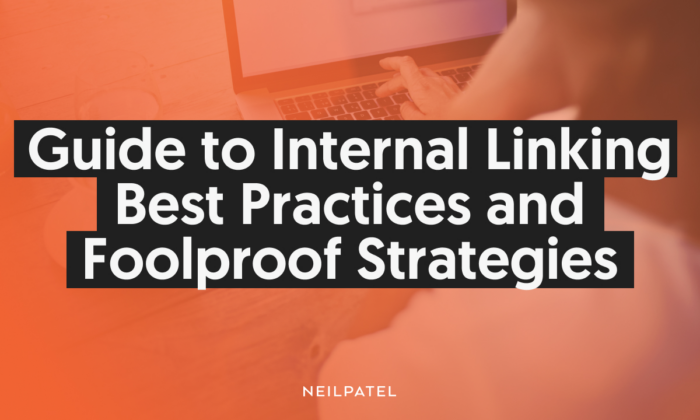
Internal linking is crucial to a successful SEO strategy.
Small but mighty, simple yet complex, internal links help navigate users through your digital content and give search engine crawlers information about how your website works.
Internal links are found on almost every page of the internet. You probably already use them, even if you don’t know it. (Hint: there are a couple included in this intro.)
If you want to optimize your content for SEO, you need to understand how internal links work, where to place them, and why they matter.
In this post, I’ll dive into creating an effective internal linking strategy and share some internal linking best practices.
Key Takeaways
- An internal link is a hyperlink that directs users to another page within the same domain. Internal links differ from backlinks as they don’t come from an external source.
- Internal linking enhances the user experience by connecting related content and can help improve your website’s ranking in the SERPs by facilitating crawling.
- To get the most out of internal linking, it’s important to create high-quality content and find ways to include internal links where they’re natural.
- A general recommendation is to include 5-10 links per 2,000 words, and use anchor text that clearly communicates what the link destination is.
What Is Internal Linking for SEO?
Internal hyperlinks are links from one page to another within a single domain.
These differ from external links, which point to pages on a different website.
If your website has multiple pages, you should connect them using internal linking.
Having multiple web pages attached to a singular domain allows search engine crawlers to index more content and improves your chances of ranking.
Internal linking is a simple site design and architecture issue, and the search engines expect it. All websites have a design and architecture that keeps them structured logically, such as this common silo model.
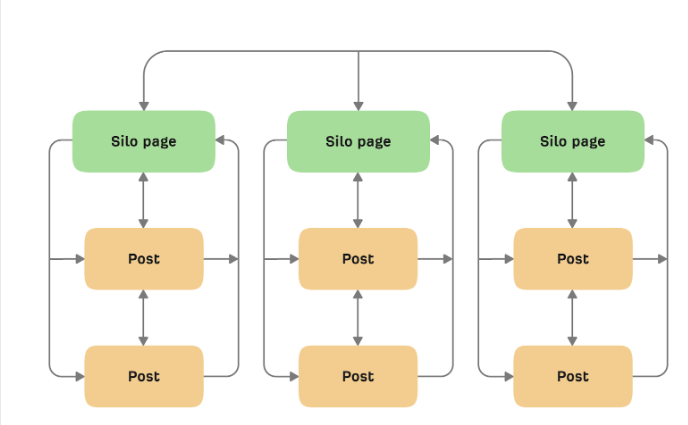
Think of your website’s home page. In the top navigation, you likely have a menu that links to other internal pages. This could be your About, Shop, and Contact pages. This internal linking structure is essential for SEO because it establishes a site architecture and improves link equity.
Why Is Internal Linking for SEO Important?
Internal linking is one of SEO’s most valuable weapons.
It’s not a trick or a gimmick, and it’s certainly not hard to do.
How do internal links help SEO? Well, here are a handful of benefits.
Internal linking for SEO helps Google index your site: If your website has strong internal linking, the Google crawler has an easier time finding new content you publish.
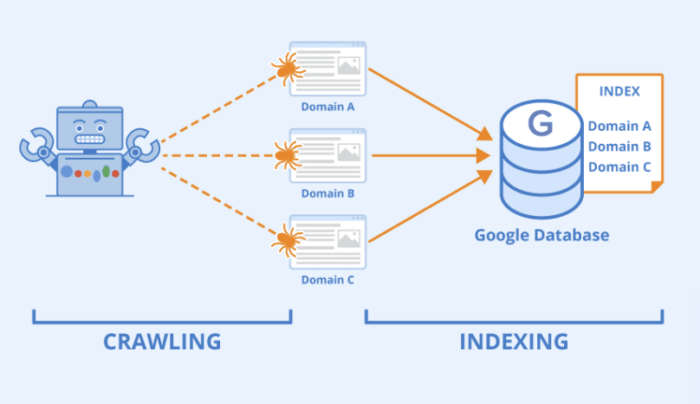
Internal linking spreads the site’s strength to internal pages: If you create a strong internal linking structure, you can boost the link juice earning potential of the internal pages by creating clear click paths and indexation throughout your site.
When your website receives a link to the homepage, some link value passes on to internal pages. The more tightly-knit a website’s structure (with a robust internal linking structure), the better the overall site performs in search engines.
Internal linking provides value to your users: Think about it this way: When you’re researching a topic, do you check one source or multiple? Do you enjoy exploring other content that reinforces your understanding of the topic?
While it may not drive conversions directly, internal linking increases the content value by backing up claims and providing related information, which improves dwell time. It has a place within the marketing funnel—carrying people to a target destination.
Even if you don’t care about the technical value of internal linking, at least do it for your user experience.
Internal Linking Best Practices
Now, it’s time to get into the nitty-gritty. How do you do internal linking? What’s the best method for creating the biggest value with links? How many internal links should appear per page for SEO?
Let’s get into it.
1. Link to and From Content-Heavy Pages
The best internal links connect one article to another, creating a strong internal linking structure deep within the site.
With good site architecture, you’ll have enough links to your site’s main pages, such as the homepage, About page, Contact page, etc. You don’t need more links to these pages.
Obviously, if you’re trying to drive conversions using a squeeze page or sales page and the opportunity is right, link to it.
Mostly, I recommend creating links in and among long-form articles. This automatically spreads your internal linking naturally.
2. Create Text Links Using Anchor Text
What kind of internal links work best for SEO? Links with descriptive anchor text.
What do we mean by descriptive anchor text?
Anchor text is the word or words that link to another page. It typically appears as blue text to the reader. This is anchor text.
Descriptive anchor text uses phrases that describe what the target link is about. For example, if you wanted to link to an article about Google’s algorithm, you could do it this way:
“Check out the latest Google algorithm updates to learn more.”
See? The subject of the link inspires relevant phrases for your anchor text. You’ll want to avoid non-descriptive phrases like “click here”, as they add no value. Also, don’t hyperlink entire paragraphs. A few words are enough.
When optimizing your internal links for SEO, anchor text that flows well with the overall content versus over-optimized anchor text is best.
3. Add an Appropriate Number of Links Per Page
How many internal links are too many? Is there such a thing? Yes, definitely.
Google’s John Mueller states too many internal links can dilute their value.
As a Zyppy survey explains, “More internal links are associated with higher traffic, but only to a point.” The survey found that URLs with 50 links or more experienced declining traffic:
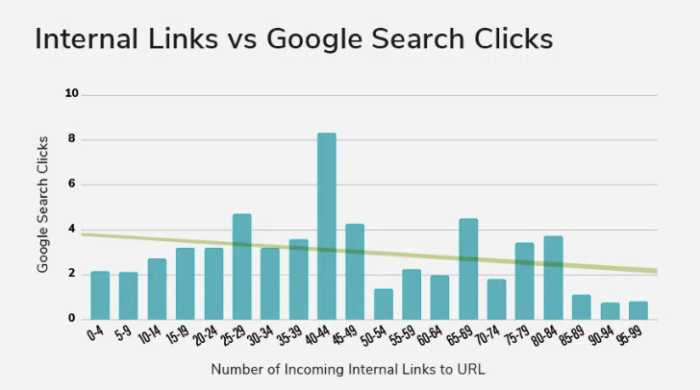
Keep your audience in mind to determine how many links are natural on a page. I’d suggest starting with at least 5 internal links. Add more if they’re relevant.
As you consider how many links to add to a page, keep in mind that you include your header, footer, and menu links in your on-page link count.
4. Update Old Articles With New Internal Links
You’ll get the most power from internal linking if you combine it with another SEO technique—updating old content.
When you update old content, Google’s crawler sees it again, indexes it again, and may increase its ranking in the SERPs.
I’ll always recommend updating your old articles regularly. Here is a good process to follow on your old blog articles:
- Add a new paragraph of content at the beginning, explaining your updates.
- Add several new paragraphs throughout, adding additional or updated information.
- Remove or replace outdated stats or information.
- Add several new internal links to content you’ve recently created.
- Add links in places where it’s logical and value-added.
Remember, internal linking isn’t only about linking new content to older content. It’s also about circling back to older content and creating internal links that connect to your newer work.
5. Add Links Where It Makes Sense
It’s tempting to get lazy and throw your links in at the end of an article: “For more awesome content, click here!”
Don’t do that, please. Or at least, don’t do just that.
Instead, look for areas in your content where the subject matter overlaps. These are logical points of connection to create an internal link. For example, you can add links to define complex terms or explain a related topic.
6. Only Add Dofollow Links
Don’t add a nofollow tag to your internal links. Nofollow links don’t impact the search engine rankings of the destination site.
On top of that, Google does not transfer PageRank or anchor text across nofollow links. It won’t even crawl them.
While some data from Semrush shows nofollow links can be useful when used externally as they can drive traffic to your site, there is no reason to use them in your internal linking strategy.
7. Take Site Navigation and Information Architecture Into Consideration
Site navigation and internal linking go hand in hand. Internal linking defines site architecture and hierarchy by creating funnels that direct users through your website.
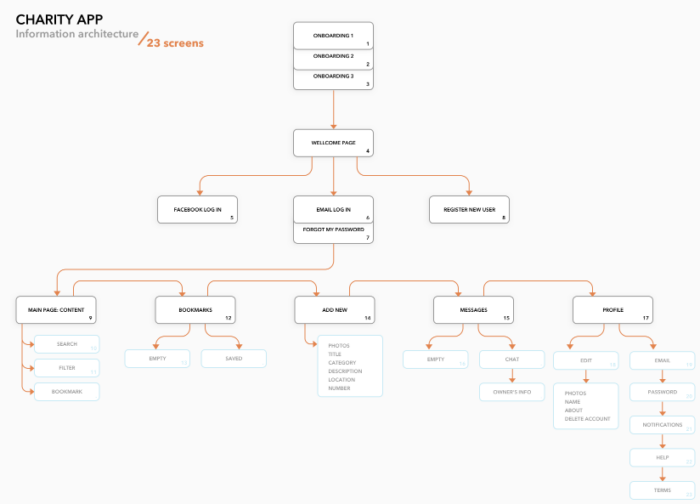
Ultimately, this is an important part of your UX/UI and impacts how long people stay on your web pages and how often they come back.
When building an internal linking strategy, consider the most important content on your site and how you’re promoting it.
If you have a piece of cornerstone content that you want more eyes on, point more internal links to it.
8. Create High-Quality Content
The best way to have a healthy internal linking structure is to have lots of internal pages to link between. Remember, simply having a lot of web pages doesn’t equal a robust internal linking strategy.
While internal links are essential to your website navigation, repeatedly linking to your homepage won’t move the needle on your SEO score.
Instead, create high-quality content that meets the needs of your target audience at various stages of their buying journey. Including internal links naturally can nudge them to the next step. Write blog posts that educate and answer their questions, create high-converting landing pages that sell your solutions, and keep adding those internal links.
9. Regularly Audit Internal Links
A regular internal link audit allows you to check for common content issues like broken links and outdated references, contributing to the overall user experience.
Another area you’ll want to check for is unnecessary redirect chains. Addressing those issues can improve page loading times and minimize negative user experiences.
You can use tools like ScreamingFrog to identify broken links and audit for redirects.

Performing internal link audits also helps you identify new linking opportunities, ensure internal linking best practices, and check for orphan pages (which don’t have any links).
I recommend doing a link audit every four to six weeks.
Internal Linking Practices to Avoid
Now that you know how to use internal links for SEO correctly, let’s review some of the practices to avoid.
Don’t overdo it! Avoid keyword stuffing in anchor text. This black hat tactic was popular in the past, as marketers thought it would improve their chances of ranking. These days, sophisticated search algorithms penalize keyword stuffing in anchor text. So, don’t do it.
Avoid using internal links in header text. Links in headers signal spam to Google crawlers and can negatively impact your SEO.
Finally, be sure to check all of your internal links before posting them. Broken links don’t spread link juice and signal to Google that your website is low-quality.
FAQs
What is internal linking?
Internal linking means hyperlinking one page on your website to another. This helps readers to discover related content on your website.
What is an example of internal linking?
Internal linking is a link that points to another page within the same domain. Internal links are hyperlinks like this: Tips for building better evergreen links.
Are internal links backlinks?
No, internal links stay within your website domain. They do not come from an external source. Backlinks are external links that point to your domain.
How many internal links should I include per post?
There’s no set number, but 5-10 for every 2,000 words is a good best practice. You can, of course, use more than that, but be careful about overstuffing your content.
Should I add internal links to my pages with more or less traffic?
According to Internal Link Juicer, internal links can spread link juice from low-traffic web pages to high-traffic ones. That being said, it’s also important to point as many links as possible to your cornerstone content so it benefits from increased traffic.
{
“@context”: “https://schema.org”,
“@type”: “FAQPage”,
“mainEntity”: [
{
“@type”: “Question”,
“name”: “What is internal linking?”,
“acceptedAnswer”: {
“@type”: “Answer”,
“text”: “
Internal linking means hyperlinking one page on your website to another. This helps readers to discover related content on your website.
”
}
}
, {
“@type”: “Question”,
“name”: “What is an example of internal linking?”,
“acceptedAnswer”: {
“@type”: “Answer”,
“text”: “
Internal linking is a link that points to another page within the same domain. Internal links are hyperlinks like this: Tips for building better evergreen links.
”
}
}
, {
“@type”: “Question”,
“name”: “Are internal links backlinks?”,
“acceptedAnswer”: {
“@type”: “Answer”,
“text”: “
No, internal links stay within your website domain. They do not come from an external source. Backlinks are external links that point to your domain.
”
}
}
, {
“@type”: “Question”,
“name”: “How many internal links should I include per post?”,
“acceptedAnswer”: {
“@type”: “Answer”,
“text”: “
There’s no set number, but 5-10 for every 2,000 words is a good best practice. You can, of course, use more than that, but be careful about overstuffing your content.
”
}
}
, {
“@type”: “Question”,
“name”: “Should I add internal links to my pages with more or less traffic?”,
“acceptedAnswer”: {
“@type”: “Answer”,
“text”: “
According to Internal Link Juicer, internal links can spread link juice from low-traffic web pages to high-traffic ones. That being said, it’s also important to point as many links as possible to your cornerstone content so it benefits from increased traffic.
”
}
}
]
}
Conclusion
Internal linking is a core part of a solid SEO strategy. When done right, it enhances your user experience and can help you rank higher in the SERPs.
While internal links are a part of any strong website design, it’s important to also find ways to include them in your long-form content.
Be sure to optimize (but not over-optimize) anchor text and include internal links that provide users with more information about a topic they’re interested in.
For the best results, always keep best practices in mind, like creating high-quality content, linking to your highest converting pages, and only adding links where it makes sense.

